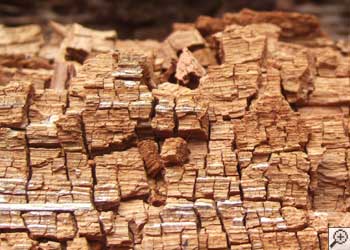Proudly serving Southwestern Ontario including London, Windsor, Chatham, Sarnia and nearby
Dry Rot & Brown Rot in Basements & Crawl Spaces

Damage from dry rot creates small, rectangular pieces of crumbling wood on the surface. Dry rot damage is often mistaken as a termite infestation.
Dry rot (also known as brown rot) is one of the most damaging forces on household wood in the world.
Billions of board feet of timber are destroyed by wood rot in Canada and the United States each year-- far more destroyed wood than is damaged annually by fire!
Replacement wood used to repair damage caused by wood rot accounts for a significant amount of annual wood production. In fact, in the United Kingdom, dry rot problems have been credited for dealing about 150 million pounds worth of damage annually.
Advanced Basement Systems has a long history of experience in eliminating, preventing, and controlling dry rot infestations in homes throughout the Ontario, including Windsor, London, Sarnia, Chatham-Kent, St Thomas, Stratford, Leamington, Essex, Amherstburg, Strathroy, Wallaceburg, Hanover, Kincardine, Point Edward, Tecumseh, and areas nearby. If you have a dry rot problem in your home and would like more information, call or e-mail us today for a free dry rot control estimate!
What is Dry Rot & Brown Rot?
"Dry Rot" is a term most often used to describe a particular kind of dry, cracking, rotting wood. However, dry rot occurs because of a variety of brown rot species, most notably the "true" dry rot fungus known as Serpula lacrymans. Dry Rot originally got its name from the thought that it didn't need water to live, but instead used a fermentation process to survive. Research long ago proved that theory untrue, and dry rot is now more appropriately called "brown rot."
However, dry rot needs much less moisture than other types of wood rotting fungi -- a wood moisture content of just 28-30% -- to survive. While there is no official proof on the subject, many contractors have observed that dry rot also will not grow on wood with too much moisture.
Protect Your Home From Dry Rot! |
|||
|
The Bad News |
The Good News |
||
|
|
||
Identifying & Treating Dry Rot or Brown Rot Problems in Ontario

Damage from dry rot creates small, rectangular pieces of crumbling wood on the surface. Dry rot damage is often mistaken as a termite infestation.
A common first indication of dry rot in a home is the appearance of a "red brick dust".
This is actually an accumulation of fungal spores that are covering the surface, waiting for the proper conditions to start to grow.
An outbreak of dry rot commonly occurs several months after a household water event, such as flooding, bursting washing machine hoses, a failed water heater, or leaking pipes.
Dry rot is also common in vented crawl spaces and basements with groundwater flooding.
Dry rot is often not detected until the damage is already very significant. At this point, the following steps are recommended:
Steps to Dry Rot Cleaning & Repair
- Remove Damaged Wood: All wood that shows decay or visible fungus should be removed, as well as all wood within one meter of the visible decayed material.
- Remove Materials Near Damage: Plaster, paneling, linings, and ceilings around the dry rot areas can also contribute to the damage and should also be removed.
- Clean The Area: Using a wire brush, clean off all surfaces -- including metal and pipes -- within 1.5 meters of the furthest edge of the infection. Clean up all dust and debris from the work.
- Disinfect area: A disinfectant is applied to all wood, masonry, and exposed soil in within 1.5 meters from the damage.
- Rebuild: Substantially rot-damaged beams, joists, and posts are replaced with pressure-treated wood.
Preventing Dry Rot in a Basement: Remove all standing water sources, then install a plastic vapor barrier on the walls and floors. Install a self-draining dehumidifier powerful enough to dry the area. (At least a 100-liter model)
Preventing Dry Rot in a Crawl Space: Seal off all crawl space vents and door covers. Encapsulate the crawl space with a crawl space liner, then install a self-draining crawl space dehumidifier.
Dry Rot Alert!
Architect's Journal reports that dry rot can grow through damp mortar, concrete, masonry and behind plaster.
This makes remediation of dry rot complicated and expensive, and it can lead to future problems with dry rot if it's not treated properly.
Preventing Dry Rot Problems in Your Basement or Crawl Space
Advanced Basement Systems can help you eliminate dry rot problems at their source. We can dry your basement or crawl space, eliminate flooding problems, and seal out outside humidity.
This not only eliminates dry rot problems, but also creates an environment that's inhospitable to mould, wet rot, and mildew, while keeping out termites, carpenter ants, cockroaches, crickets, and other household pests.
We offer FREE, no-obligation dry basement and crawl space quotes in all our service areas. We can answer all your questions and point out the sources of humidity and moisture in your home.
We operate in the Ontario area, including Windsor, London, Sarnia, St Thomas, Chatham-Kent, Leamington, Stratford, Amherstburg, Strathroy, Essex, Wallaceburg, Hanover, Kincardine, Point Edward, Tecumseh.
Looking for a price? Get a no cost, no obligation free estimate.

